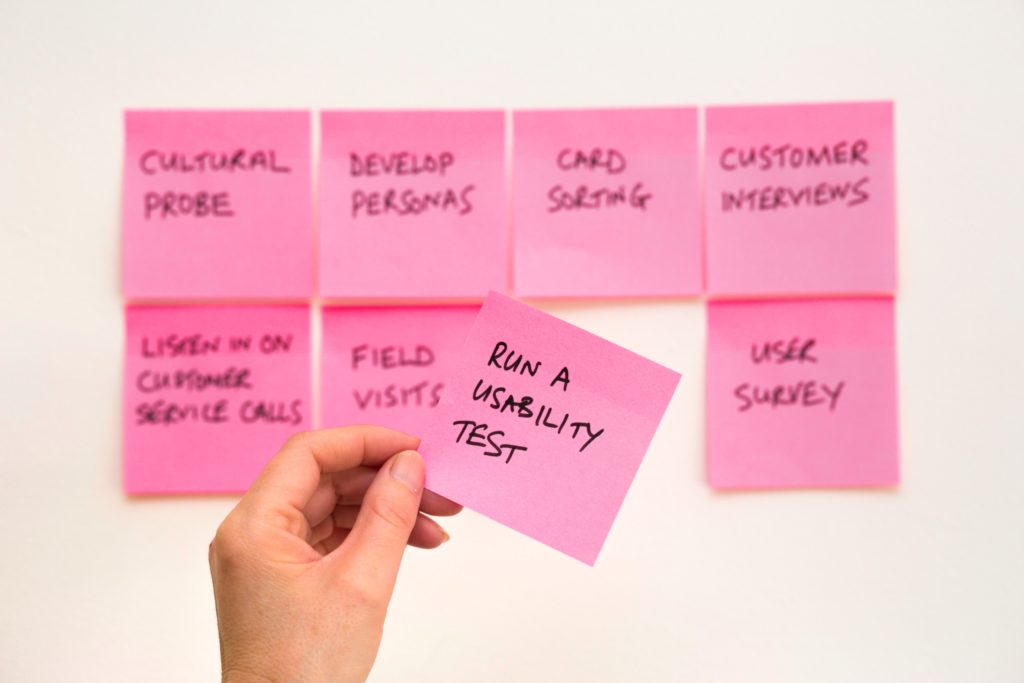There are a lot of usability testing methods out there. “Universal Methods of Design” by Bella Martin & Bruce Hanington list 101 methods of how to evaluate a design. So if you want to learn more about it, check the book out.
Depending on the state where you are in your design process, there are different methods you can or even should use.
I’m going to describe 5 widely used methods. What they are, when it is most useful and how to do it.

Moderated User Testing
There are a lot of different user testing submethods. You can do it face-to-face, separately, users can do it themselves, etc. It means that potential customers test certain situations. The researches cannot help the user nor give any hints. The test is taped to analyze the test afterward. After the tapes are analyzed the changes can be applied based on the findings.
It is mostly used when a company has at least some wireframes. It should be done in the beginning in order to determine whether your future potential clients actually like your concept and how they would use it.
Start by defining the problem. Write down some test cases which help you monitor the users’ actions in the system. Make sure the test case ends with an open question. Find suitable test users – people, who would be your potential customers. Conduct the tests. Remember not to help the user nor give them any hints. Record the test. Afterward, analyze the tapes. Note that N/N Group has identified that 5 users will give you the optimal feedback for the next changes.
A/B Testing
With this method, you can test a specific section by comparing two or more potential solutions. E.g. CTA button color, search box location. In order to conduct the research use specific programs for data collection. In the end, the data will show which thesis provided a more positive response.
It is mainly used when you want to improve the current user experience by tweaking little parts of the solution.
The easiest way to conduct an A/B testing is to use a specific program. E.g. Google Analytics, Optimizely, Unbounce. Think of a thesis for possible 2 (or more) solutions that you want to test. Put them live with the program and monitor the results for some time. At the end of the testing period, you should have enough data to make the best decision.
Benchmarking
With benchmarking you compare your current feature or future vision to with your competitors on a scale. By comparing your solution to your competitors, you will find which feature is better or worse from you and how.
You can do it in the very beginning or even when you have your solution out there. If you love pen and paper, then this is doable on it.
Write down the most worrying features that you might want to compare. Decide which kind of scale would you like to use. E.g. -5…0…5 or -100%…0…100%, etc. Set your solution to be the middle point. Next, compare these points to your competitors’ same features. Add notes of what makes their solution better or worse than yours. Apply findings according to your findings.
Card Sorting
It is used to plan web page/app/program navigation. Test users place given cards into a certain order, in which directory they expect to find the needed information.
This method should be used at the beginning of
Use either paper cards or special programs. Preset the cards by writing down your hypothetical directory step-by-step. This testing can be done face-to-face or virtually with the help of a program. Apply findings to your navigation.
Questionaire
Widely known and possibly the easiest way to validate product ideas within a group of people. It is valuable because it shows you the potential customers mindset towards your idea.
Most useful to validate any new product or service need. Therefore the best time would be in the very beginning of your idea phase. Maybe you want to launch a new service or product series, but in order to know if people are actually interested in it use a questionnaire.
When starting to use it, think about the end goal. What do you want to know? What is the current problem that needs solving? Think of the questions that should help get needed information. Use any questionnaire provider that you want. E.g. Google Forms,
Conclusion
When you start testing your products or services, the main question should still be: “What is the problem I’m aiming to solve?” By figuring and formulating it, the most crucial part of the process is done. When you have successfully pinpointed the main issue, evaluate how far are you currently with the solution. The suitable methods for your case are easier to find if you know the issue and how far are you within the design process. In the end, you need customer feedback. In order to get the knowledge you are seeking, you need to know what and how you should ask it from the customers.
